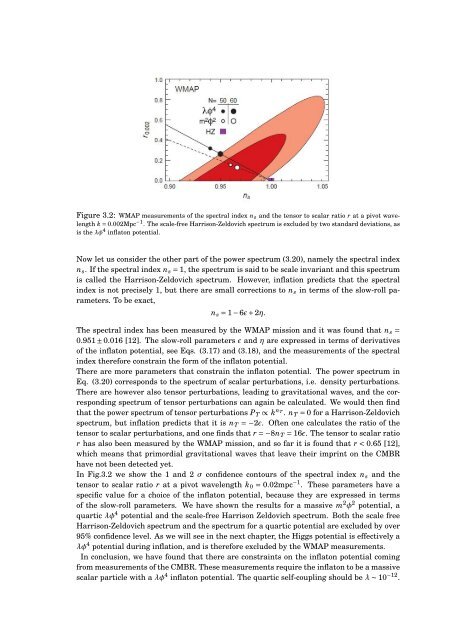Master's Thesis in Theoretical Physics - Universiteit Utrecht
Master's Thesis in Theoretical Physics - Universiteit Utrecht
Master's Thesis in Theoretical Physics - Universiteit Utrecht
You also want an ePaper? Increase the reach of your titles
YUMPU automatically turns print PDFs into web optimized ePapers that Google loves.
Figure 3.2: WMAP measurements of the spectral <strong>in</strong>dex n s and the tensor to scalar ratio r at a pivot wavelengthk = 0.002Mpc −1 . The scale-free Harrison-Zeldovich spectrum is excluded by two standard deviations, asis the λφ 4 <strong>in</strong>flaton potential.Now let us consider the other part of the power spectrum (3.20), namely the spectral <strong>in</strong>dexn s . If the spectral <strong>in</strong>dex n s = 1, the spectrum is said to be scale <strong>in</strong>variant and this spectrumis called the Harrison-Zeldovich spectrum. However, <strong>in</strong>flation predicts that the spectral<strong>in</strong>dex is not precisely 1, but there are small corrections to n s <strong>in</strong> terms of the slow-roll parameters.To be exact,n s = 1 − 6ɛ + 2η.The spectral <strong>in</strong>dex has been measured by the WMAP mission and it was found that n s =0.951 ± 0.016 [12]. The slow-roll parameters ɛ and η are expressed <strong>in</strong> terms of derivativesof the <strong>in</strong>flaton potential, see Eqs. (3.17) and (3.18), and the measurements of the spectral<strong>in</strong>dex therefore constra<strong>in</strong> the form of the <strong>in</strong>flaton potential.There are more parameters that constra<strong>in</strong> the <strong>in</strong>flaton potential. The power spectrum <strong>in</strong>Eq. (3.20) corresponds to the spectrum of scalar perturbations, i.e. density perturbations.There are however also tensor perturbations, lead<strong>in</strong>g to gravitational waves, and the correspond<strong>in</strong>gspectrum of tensor perturbations can aga<strong>in</strong> be calculated. We would then f<strong>in</strong>dthat the power spectrum of tensor perturbations P T ∝ k n T. n T = 0 for a Harrison-Zeldovichspectrum, but <strong>in</strong>flation predicts that it is n T = −2ɛ. Often one calculates the ratio of thetensor to scalar perturbations, and one f<strong>in</strong>ds that r = −8n T = 16ɛ. The tensor to scalar ratior has also been measured by the WMAP mission, and so far it is found that r < 0.65 [12],which means that primordial gravitational waves that leave their impr<strong>in</strong>t on the CMBRhave not been detected yet.In Fig.3.2 we show the 1 and 2 σ confidence contours of the spectral <strong>in</strong>dex n s and thetensor to scalar ratio r at a pivot wavelength k 0 = 0.02mpc −1 . These parameters have aspecific value for a choice of the <strong>in</strong>flaton potential, because they are expressed <strong>in</strong> termsof the slow-roll parameters. We have shown the results for a massive m 2 φ 2 potential, aquartic λφ 4 potential and the scale-free Harrison Zeldovich spectrum. Both the scale freeHarrison-Zeldovich spectrum and the spectrum for a quartic potential are excluded by over95% confidence level. As we will see <strong>in</strong> the next chapter, the Higgs potential is effectively aλφ 4 potential dur<strong>in</strong>g <strong>in</strong>flation, and is therefore excluded by the WMAP measurements.In conclusion, we have found that there are constra<strong>in</strong>ts on the <strong>in</strong>flaton potential com<strong>in</strong>gfrom measurements of the CMBR. These measurements require the <strong>in</strong>flaton to be a massivescalar particle with a λφ 4 <strong>in</strong>flaton potential. The quartic self-coupl<strong>in</strong>g should be λ ∼ 10 −12 .
















